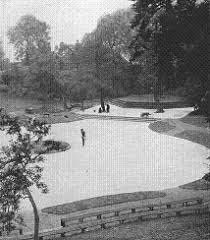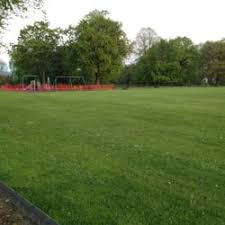The land on which ‘Muntz Park’ lies was once part of Selly Farm which stood at the corner of Warwards Lane and St Stephen’s Road, owned by the Muntz family since the early 19th century but farmed by successive generations of the Worwood family.
However, from the third quarter of the nineteenth century, such areas of farmland, so close to the ever expanding Birmingham were being bought up for new housing. In 1904 approval was given for the construction of two new roads on Mr Muntz’ land, leading off Raddlebarn Road—the future Umberslade and Gristhorpe Roads. (Cherington and Rissington were added after 1911). Housing soon followed the creation of these new roads.
Raddlebarn SchoolVery soon after, on 20th May 1905 Frederick Ernest Muntz gave three acres of land to the district council to be used as a park. In 1907 and 1909 the council bought a further two acres from him, adjacent to their new school, Raddlebarn School, to make the five acres of park.
The Birmingham Civic Society’s Plans for The DellThe park was used from its earliest days for music, dancing and games. In recognition of its use by local people, the Civic Society in 1923 gave a grant of £300 to re-landscape the park extensively. An amphitheatre of sorts was created with a paved central area for dancing, known and ‘The Dell’, a raised paved platform, provision for erecting a maypole and a further dais for use as a bandstand. Footpaths and rustic seats were added and the whole area was planted with trees and shrubs to create ‘a charming sylvan setting’.
The new dell was opened in June 1923 by the Lord Mayor of BirminghamThe park has been used over the years for open air concerts and dances. The Bournbrook Entertainment Committee organised dances every Monday and Wednesday evening during the summer. Entrance cost 4d if you wanted to dance and 2d if you preferred to ‘kick your heels and watch coyly from the edge’. It was not unusual for 400 or 500 people to turn up.
Various other events were staged, Sunday night concerts, Police Band, Wards male voice choir, Raddlebarn Men's Choir. It became a focal point in the community. Raddlebarn Lane School used it as an open air theatre.
Dancing in the dell 1946A large number of adults used to stand round the railings at the top and watch the concerts without paying. So in later years shrubs were planted to obscure the view from the top.
Postcard of Path and GardensChildhood memories from the mid 1920’s: “The Park Keeper Mr Finch, he was a terror to us lads. He was a keen gardener, he had roses and climbing roses over bowers, geraniums and spring flowers all over the place. Goodness help you if your ball went on a bed!”
“We used to stand and count the bats as they came out of the two beech trees and then we knew that it was time to go home.”
During World War II there was a communal air raid shelter built under the park (near where the Children’s Playground is today). This shelter could accommodate several dozen people.



